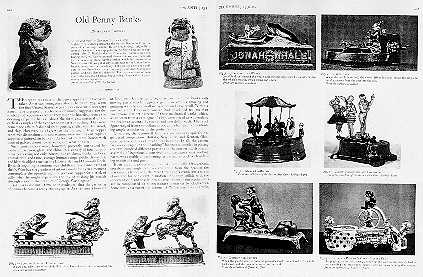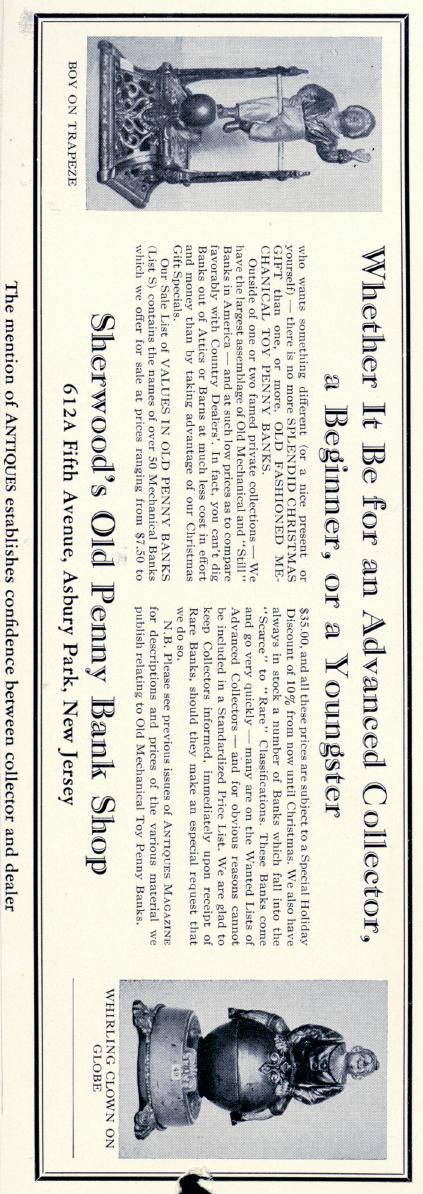ANTIQUES — DECEMBER, 1936
Old Penny Banks
By Andrew Emerine
THE urge to take care of the pence appears to have overtaken American youngsters about the year 1793, when the first United States large copper one-cent pieces were issued. The presence of such coins obviously suggested the desirability of repositories where they might be hoarded. Hence the devising of penny banks. About the form and material of the earliest examples of the type we know little or nothing. They were homemade affairs fashioned from gourds, shells, whittled wood, and clay. However, by 1857, when the minting of large copper cents was discontinued, manufacturers were turning out copious supplies of painted tin banks in the form of churches, houses with pointed gables, drums, bandboxes, and what not else.
 Such contrivances were, however, presently outrivaled
by banks of cast iron, glass, and china, in a variety of fanciful patterns portraying not
only houses, but chickens, ducks, turkeys, animals wild and tame, average human beings,
public characters, and historic objects such as the Liberty Bell and Plymouth Rock. By
such beguiling inventions was childhood lured into paths of thrift. Who but the greediest
of infants would for even a moment contemplate the squandering of a precious copper for a
stick of taffy when he might experience the joy of pushing his wealth through a slot in
the cranium of George Washington?
Such contrivances were, however, presently outrivaled
by banks of cast iron, glass, and china, in a variety of fanciful patterns portraying not
only houses, but chickens, ducks, turkeys, animals wild and tame, average human beings,
public characters, and historic objects such as the Liberty Bell and Plymouth Rock. By
such beguiling inventions was childhood lured into paths of thrift. Who but the greediest
of infants would for even a moment contemplate the squandering of a precious copper for a
stick of taffy when he might experience the joy of pushing his wealth through a slot in
the cranium of George Washington?
But it was not until 1870, or thereabouts, that the garnering of pennies became a really exciting sport. At that time a foundry at Cromwell, Connecticut, began to turn out iron banks with moving parts which juggled a penny in various amazing and amusing ways before swallowing it beyond easy recall. Within a few years the Cromwell concern had developed no less than twenty-one distinct patterns of these mechanical banks, which, as we learn from a catalogue of 1873, were priced wholesale to the dealer at seventy-five cents and one dollar each. The retail figure ranged from two dollars to two and a half each, thus affording ample stimulation to the profit motive.
Of course, the Cromwell factory’s success very quickly engendered competition. Buffalo, New York, and Kenton, Ohio, soon became centres of mechanical banking. In all, the various factories engaged in the "banking" business succeeded in placing over two hundred different patterns on the market. Each one, an assembly of ingeniously contrived and accurately cast working parts, was capable of performing its particular trick with unfailing exactitude and gusto.
 Even today a penny shot from William Tell’s
fifty-year-old crossbow unerringly removes the apple from the head of the marksman’s
heroic son; the mere turning of a crank sets a circus clown and his pony cart in motion
until they collide with the expectant coin and toss it into a barrel. Some of the
mechanisms are so complicated as to necessitate operation by clockworks. Some involve a
variety of actions. A Bad Accident, for example plucks a pickaninny from
behind a bush, thus frightening a donkey, which in turn upsets an apple cart and seriously
disturbs the equanimity of a darkey boy who has been engrossed in the consumption of a
watermelon. Again, Jonah and the Whale contrive between then to absorb what
small copper contributions are vouchsafed, and a singularly abnegative Uncle Sam
contentedly accepts equally insignificant donations for deposit in the carpetbag beside
him.
Even today a penny shot from William Tell’s
fifty-year-old crossbow unerringly removes the apple from the head of the marksman’s
heroic son; the mere turning of a crank sets a circus clown and his pony cart in motion
until they collide with the expectant coin and toss it into a barrel. Some of the
mechanisms are so complicated as to necessitate operation by clockworks. Some involve a
variety of actions. A Bad Accident, for example plucks a pickaninny from
behind a bush, thus frightening a donkey, which in turn upsets an apple cart and seriously
disturbs the equanimity of a darkey boy who has been engrossed in the consumption of a
watermelon. Again, Jonah and the Whale contrive between then to absorb what
small copper contributions are vouchsafed, and a singularly abnegative Uncle Sam
contentedly accepts equally insignificant donations for deposit in the carpetbag beside
him.
It is such mechanical banks that today are in demand among a number of collectors variously located all the way from New York to California. As a result, almost any still-functioning example of the type will bring more than its original selling price, while rare items command still higher valuations. Certain collectors give at least a little attention to the non-mechanical or "dumb" banks, which, it may be said, offer a choice of two hundred patterns. In general, however, examples of the latter type are not considered attractive.
The pence-engulfing movements of the banks illustrated are obvious.
Captions under photos:
Fig. 1 (left and right) — GENERAL BUTLER (1884). A ghastly caricature portraying the worthy Benjamin F., in the guise of a bullfrog. General Butler (1818-1893), originally a staunch Democrat, was unpopular in the North because he supported John C. Breckinridge as Presidential nominee in 1860. During the Civil War he aroused violent animosity in the South by the severe military administration which he instituted in New Orleans following that city’s surrender to the Union forces. In 1884 he ran for the Presidency of the United States as candidate of the Greenback (paper currency) and Anti-Monopolist parties, and was dismally defeated. The representation of General Butler as a green-backed frog carrying a huge wallet of paper money is thus explained. From the collection of Wesley Hallett.
Fig. 2 — BUCKING GOAT AND HUNGRY FROG. A rare and early item of its kind. Only three have thus far been accounted for. From the author’s collection.
Fig. 3 — JONAH AND THE WHALE. Jonah is thrust toward the whale, and the coin slips from his shoulders into the whale’s mouth, which opens and shuts. From the author’s collection.
Fig. 4 — CIRCUS BANK. When the crank is turned, the clown drives his pony about the ring and knocks the coin from the post into the box. From the Author’s collection.
Fig. 5 — MERRY-GO-ROUND. From the collection of the Boston Five Cents Savings Bank.
Fig. 6 — CLOWN, HARLEQUIN, AND COLUMBINE. From the collection of the Boston Five Cents Savings Bank.
Fig. 7 — DENTIST AND PATIENT. When the gleeful dentist pulls his patient’s tooth, the colored victim falls backward, and the coin is deposited in the bank. From the collection of James C. Jones.
Fig. 8 — PROFESSOR PUGFROG’S GREAT BICYCLE FEAT. The pugfrog makes two turns, depositing the coin in the clown’s basket and knocking the music rack against Mother Goose’s waggable tongue. From the collection of James C. Jones.
Fig. 9 — COLORED MAMMY. From the collection of William F. Ferguson.
Fig. 10 — THREE CLOWNS AND ELEPHANT ON A TUB. From the collection of William F. Ferguson.
Fig. 11 — MONKEY AND COCONUT. From the author’s collection.
Fig. 12 — THE INITIATING BANK, FIRST DEGREE. From the collection of Elmer Rand Jacobs.
Fig. 13 — RECLINING CHINAMAN, WITH PLAYING CARDS. From the collection of Doctor Ralph W. Crane.
Fig. 14 — ATLAS BANK. From the collection of Elmer Rand Jacobs.
Fig. 15 — GIRL SKIPPING ROPE. From the author’s collection.
Fig. 16 — PIG IN HIGHCHAIR. From the collection of Dr. Ralph W. Crane.
Fig. 17 — MILKING COW. From the collection of Edwin R. Marshall.
Fig. 18 — HUNGRY DINAH. From the collection of Edwin R. Marshall.
Fig. 19 — MONKEY WITH TRAY (tin). From the collection of F. H. Wieder.
Fig. 20 — "BRITISH LION" (tin). From the collection of F. H. Wieder.
Fig. 21 — SINKING OF THE SPANISH FLEET. From the collection of Walter P. Chrysler.
Fig. 22 — BULL AND BEAR. From the collection of Walter P. Chrysler.
ANTIQUES
MAGAZINE, December, 1936
(text below)

Whether It Be for an
Advanced Collector,
a Beginner, or Youngster
who wants something different (or a nice
present for yourself) — there is no more SPLENDID CHRISTMAS GIFT than one, or
more, OLD FASHIONED MECHANICAL TOY PENNY BANKS.
Outside of one or two famed private collections — We
have the largest assemblage of Old Mechanical and "Still" Banks in America — and
at such low prices as to compare favorably with Country Dealers'. In fact, you
can't dig Banks out of Attics or Barns at much less cost in effort and money
than by taking advantage of our Christmas Gift Specials.
Our Sale List of VALUES IN OLD PENNY BANKS (List S)
contains the names of over 50 Mechanical Banks which we offer for sale at prices
ranging from $7.50 to $35.00 and all these prices are subject to a Special
Holiday Discount of 10% from now until Christmas. We also have always in stock a
number of Banks which fall into the "Scarce" to "Rare" Classifications. These
Banks come and go quickly — many are on the Wanted Lists of Advanced collectors
— and for obvious reasons cannot be included in a Standardized Price List. We
are glad to keep Collectors informed, immediately upon receipt of Rare Banks,
should they make an especial request that we do so.
N. B. Please see previous issues of Antiques Magazine
for descriptions and prices of the various material we publish relating to Old
Mechanical Toy Penny Banks.
Sherwood's Old Penny Bank Shop
612 Fifth Avenue, Asbury Park, New Jersey
